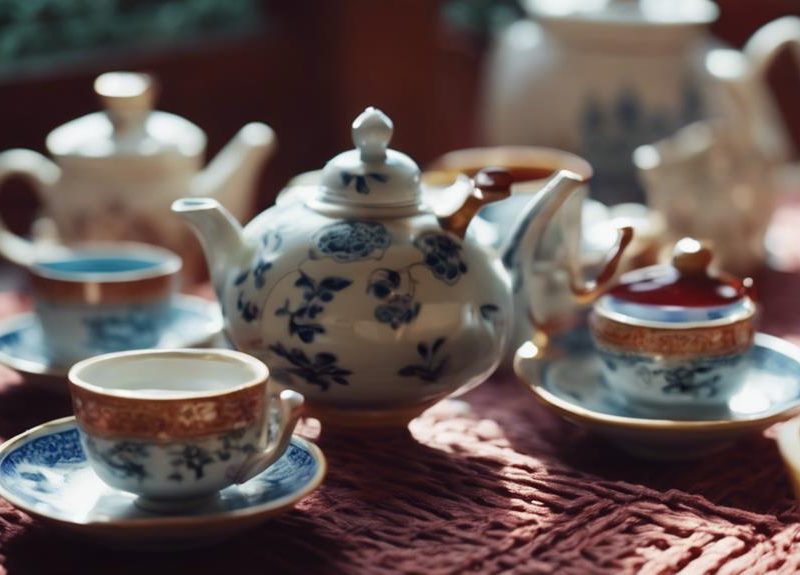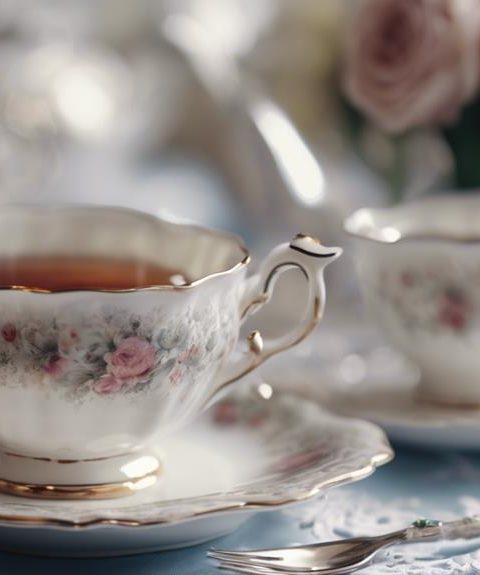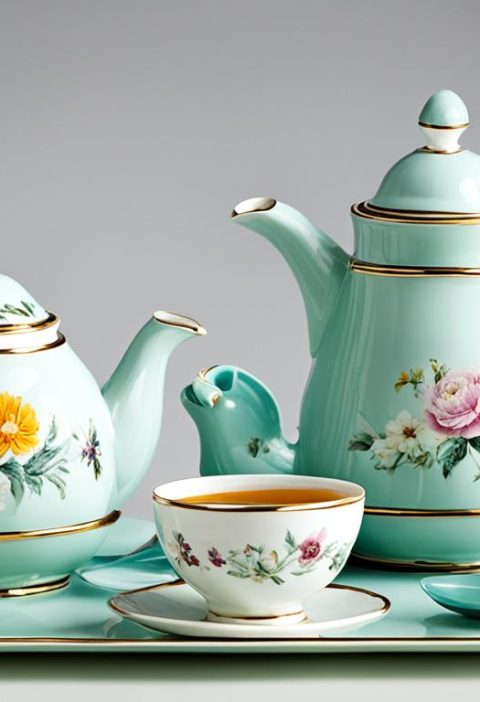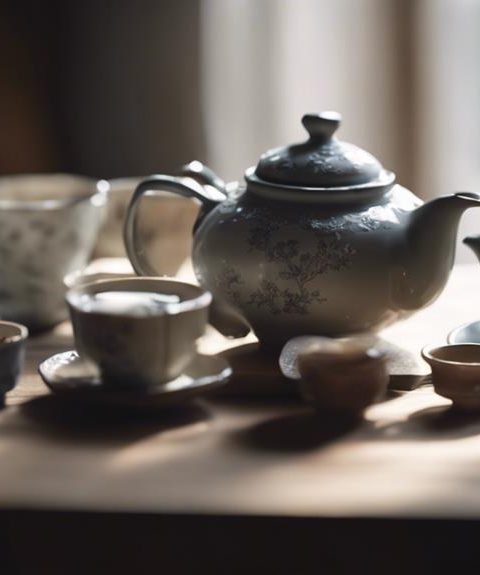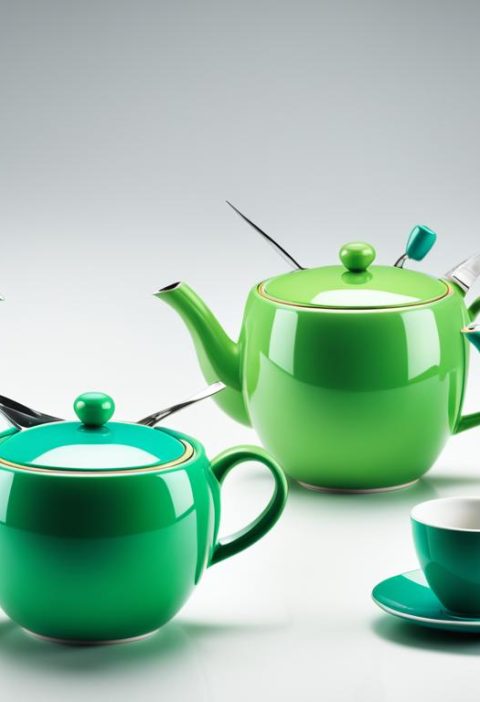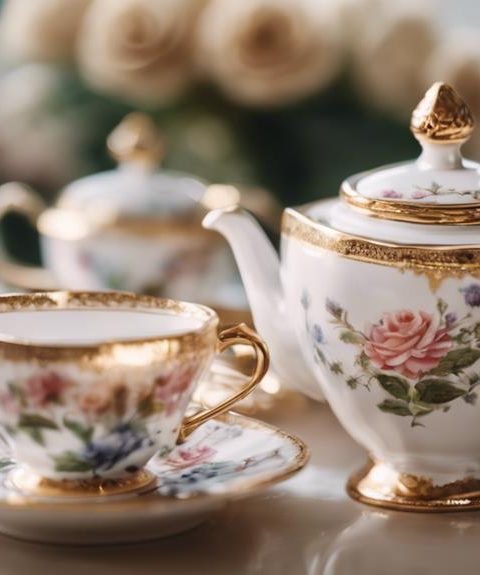Immerse yourself in a world of tea sets where a tapestry of cultures intertwines through artistry and tradition. Explore the exquisite Chinese craftsmanship, the graceful Japanese tea ceremonies, and the elegant British tea culture. Experience the warm hospitality of Moroccan tea rituals, the comforting chai traditions of India, and the ceremonial practices of the Ottoman Empire.
Delve into the splendor of Persian tea culture, the respect for tea in Korean traditions, and the diverse tea customs across Africa. Discover the earthy essence of Australian tea rituals and the camaraderie found in South American tea gatherings.
Each tea set narrates a unique story, spanning centuries and continents, showcasing the rich heritage of tea ceremonies and craftsmanship.
Key Takeaways
- Chinese tea sets are exquisite works of art that hold deep cultural significance in Chinese traditions.
- The Japanese tea ceremony is a time-honored practice that focuses on creating an atmosphere of serenity and mindfulness.
- British high tea is a refined and elegant social affair, featuring a delightful spread of savory treats and providing a space for leisurely conversations.
- Moroccan tea culture is characterized by its elegant tea ceremonies, which symbolize hospitality and warmth in Moroccan society.
- Indian chai traditions encompass a rich fusion of spices and comforting rituals that have preserved unique recipes over generations.
Tea Sets in Ancient China
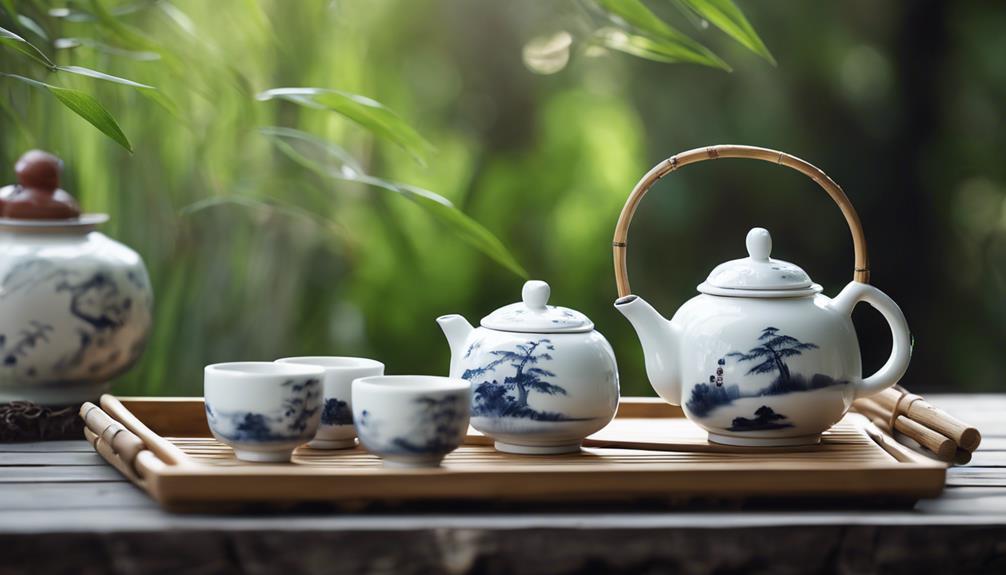
Ancient China revered tea sets as exquisite works of art, embodying rich cultural significance beyond mere utility. These meticulously crafted sets symbolized tradition and craftsmanship, reflecting the profound respect for the ritual of tea drinking, believed to foster harmony and serenity in the soul.
Crafted from delicate porcelain or renowned Yixing clay, known for its exceptional heat retention, these tea sets in ancient China were revered for enhancing the tea brewing experience. The designs ranged from simple elegance to intricate detailing, showcasing the skilled artistry of the craftsmen who created them.
Tea ceremonies in ancient China were steeped in tradition, with meticulous rituals dictating the preparation and presentation of tea. The ceremonial act of pouring tea was elevated to an art form, symbolizing reverence and appreciation for guests, embodying principles of respect and hospitality.
Exploring the historical legacy of tea sets in ancient China unveils a profound cultural narrative, highlighting the deep-rooted traditions and artistic expressions woven into these magnificently crafted objects.
Japanese Tea Ceremony Essentials
The Japanese tea ceremony, also known as Chanoyu or Sado, is a time-honored practice that revolves around the meticulous preparation and presentation of matcha, a finely powdered green tea. This ceremonial tradition embodies elegance, respect, and harmony through a series of prescribed rituals dating back centuries. Essential tools such as the chawan (tea bowl), chasen (tea whisk), chashaku (tea scoop), and fukusa (silk cloth) are integral to the ceremony, each serving a specific purpose in the graceful art of tea preparation.
During the ceremony, participants engage in precise movements and gestures, creating a serene atmosphere filled with symbolism and mindfulness. The host's graceful actions, the calming sound of boiling water, and the peaceful setting all contribute to the immersive experience of the tea ceremony. It's a practice that emphasizes tranquility, respect, and unity with nature, inviting all participants to be fully present in the moment and appreciate the beauty of simplicity and tradition.
British High Tea Elegance
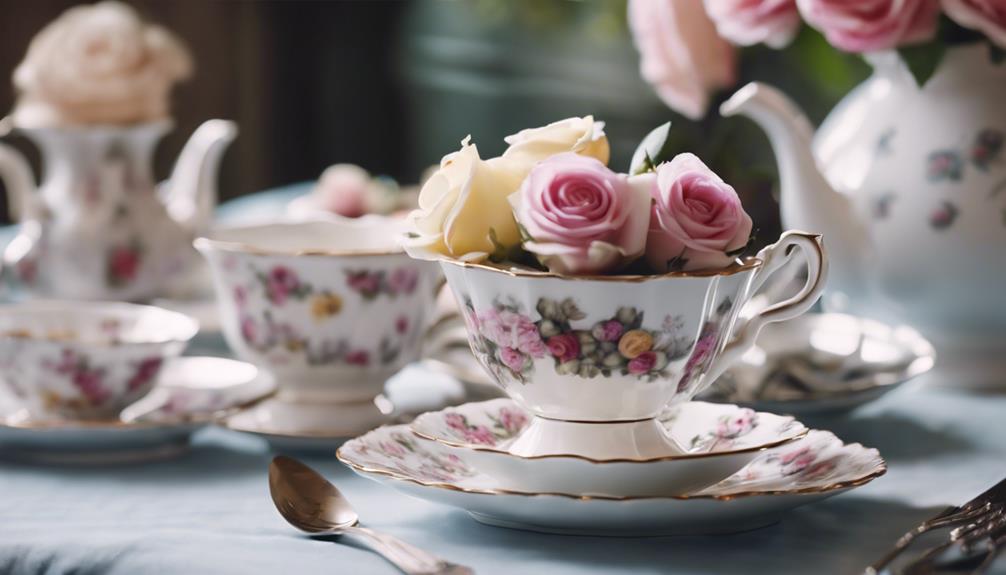
British High Tea, a symbol of refined elegance and leisurely indulgence, offers a sophisticated experience rooted in tradition. The ambiance is rich with luxury, set in beautifully decorated rooms adorned with delicate china tea sets, crisp linens, and fresh flowers. The air is filled with the inviting aroma of freshly brewed tea, creating a tranquil atmosphere for guests to unwind and savor the moment.
This exquisite affair showcases a delectable spread of both savory and sweet treats, including finger sandwiches, scones with clotted cream and jam, and an assortment of pastries and cakes. Each bite is a culinary masterpiece crafted to tantalize the taste buds and complement the tea selection perfectly. Beyond the culinary delights, British High Tea is a social occasion where lively conversations flow, laughter abounds, and time seems to pause in the midst of elegant company.
Immerse yourself in the art of taking a moment for oneself and relishing life's simple pleasures. British High Tea is a celebration of taste, elegance, and tradition—a moment of pure sophistication to indulge in.
Moroccan Tea Culture
Moroccan Tea Culture offers a rich sensory experience that blends vibrant flavors with centuries-old traditions, creating a unique tea-drinking ritual. In Morocco, tea symbolizes hospitality and camaraderie, making it a cherished part of social gatherings. Here's what sets Moroccan tea culture apart:
- Mint Tea:
Experience the delight of savoring a steaming cup of green tea infused with fresh mint leaves. The invigorating aroma evokes the lively markets of Marrakech, where the air is filled with the sweet fragrance of mint.
- Tea Ceremony:
Envision the elegant ritual of pouring tea from a beautifully adorned teapot, held high above the cup. The amber liquid flows gracefully, creating a captivating performance that goes beyond serving tea—it embodies artistry and fosters a sense of connection.
- Sweet Pairings:
Picture complementing your tea with traditional Moroccan pastries like honey-soaked chebakia or flaky almond-filled pastilla. The combination of these sweet delicacies with the slightly bitter tea results in a harmonious blend of flavors that will leave you yearning for more.
Indian Chai Traditions
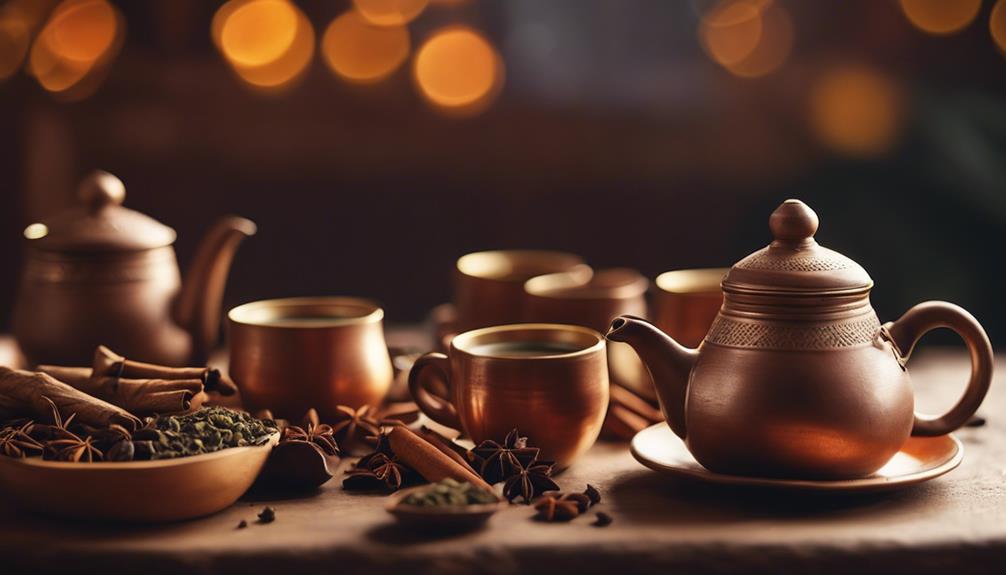
Step into the enchanting realm of Indian Chai Traditions, where a delightful fusion of spices and flavors orchestrates a captivating experience. Chai transcends its role as a mere beverage, evolving into a cherished cultural ritual in India. At the core of this tradition lies a harmonious blend of black tea, milk, sugar, and an array of spices like cardamom, ginger, cinnamon, and cloves. The result is a luscious, velvety, and comforting concoction savored throughout the day.
In the vibrant tapestry of Indian culture, chai serves as more than just a drink; it acts as a unifying force that brings individuals together. Whether relished in bustling marketplaces, quaint roadside stalls, or serene homes, chai cultivates connections and conversations. The art of preparing chai is a deeply ingrained practice, with each household preserving its unique recipe handed down through generations.
Russian Samovar Heritage
The Russian samovar, a cherished symbol of hospitality and tea-drinking traditions in Russia, has a rich history and cultural significance. Originating in the 18th century, the samovar has been a central fixture in Russian social gatherings and tea ceremonies for generations.
The samovar is a traditional tea kettle that's typically made of metal and often adorned with intricate designs. It consists of a large container for water, a chimney in the middle for holding burning charcoal or wood to keep the water hot, and a spigot for dispensing tea.
In Russian culture, the samovar is more than just a tea kettle; it symbolizes warmth, hospitality, and togetherness. It's often the focal point of gatherings, where friends and family come together to share stories, laughter, and of course, tea.
The ritual of preparing tea from a samovar involves a series of steps, each steeped in tradition and symbolism. From heating the water to brewing the tea and serving it in delicate cups, every aspect of the process is imbued with meaning and reverence.
The samovar isn't just a utensil for making tea; it's a cultural artifact that reflects the values and traditions of Russian society. Its presence at a gathering signifies the importance of connection, community, and the sharing of simple pleasures.
Samovar Symbolizes Hospitality
The Russian samovar, a cherished symbol of hospitality in Russian culture, stands as a beacon of warmth and generosity, inviting all who gather around it to partake in its tradition.
Gleaming with polished brass or silver, the samovar proudly takes center stage, exuding a welcoming aura that embraces all visitors.
The gentle hiss of boiling water within the samovar serves as a comforting backdrop, enhancing the atmosphere of relaxation and camaraderie.
With steam gracefully rising from its spout, carrying the delightful scent of freshly brewed tea, the samovar entices guests to come together, engage in conversation, and form lasting connections over a shared cup of tea.
Tea Rituals in Russia
In Russia, the tea culture is deeply rooted in traditions that revolve around the iconic Russian samovar. The samovar, symbolizing unity and coziness, holds a significant place in Russian daily life, where tea rituals embody warmth and hospitality.
Guests are welcomed with strong brewed tea served in small cups, accompanied by an assortment of sweets, jams, and pastries. The gentle bubbling and steam of the samovar create an inviting ambiance for sharing stories and fostering connections.
This cherished tradition emphasizes the importance of togetherness and camaraderie through the art of tea drinking in Russia.
Turkish Ottoman Tea Rituals
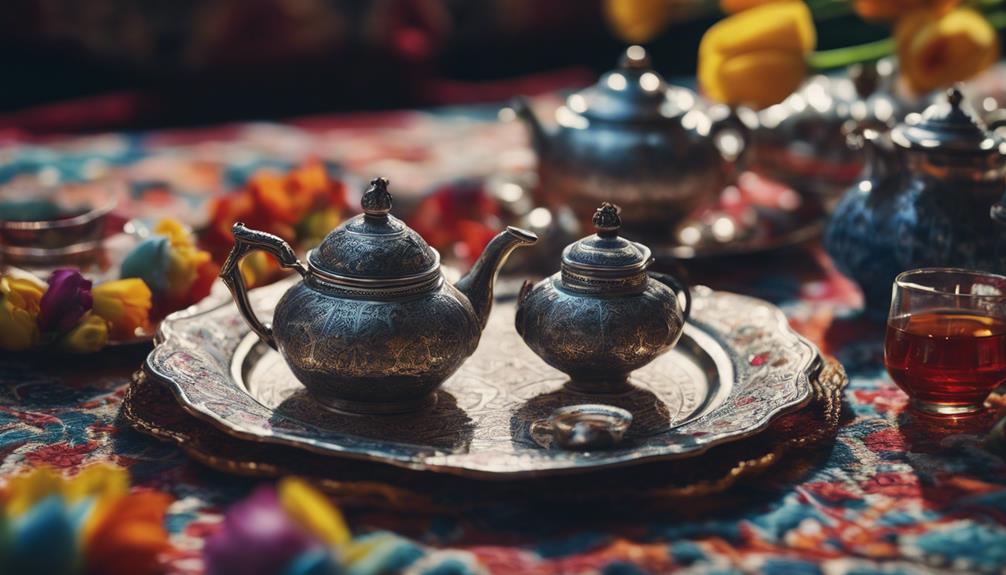
Turkish Ottoman Tea Rituals encompass a vibrant tradition deeply rooted in history, showcasing the essence of cultural heritage.
The practice of Ottoman Tea Preparation and the elaborate Tea Serving Etiquette not only revolve around the tea itself but also symbolize a profound cultural experience.
Delve into the captivating realm of Turkish tea rituals to unveil a tapestry of customs and practices that have stood the test of time.
Ottoman Tea Preparation
Immerse yourself in the intricate world of Ottoman tea preparation and experience the rich Turkish Ottoman tea ceremonies.
In the traditional Ottoman tea preparation method:
- Boil water in a special double teapot known as a 'çaydanlık,' featuring a lower pot for boiling water and an upper pot for steeping the tea.
- Infuse the top pot with loose black tea leaves and allow them to brew until the tea achieves a deep red color.
- Serve the concentrated tea in small tulip-shaped glasses, filling them one-third full, and then add hot water to adjust the strength to your preference.
This ceremonial approach to brewing Ottoman tea results in a robust and flavorful beverage meant to be savored slowly, ideally in the delightful company of friends or family.
Tea Serving Etiquette
Immerse yourself in the intricate tea serving etiquette of Turkish Ottoman tea rituals, a cultural practice steeped in tradition and grace. Turkish culture values the act of serving tea as a symbol of hospitality and friendship. During an Ottoman tea ceremony, it's customary to hold the delicate tea glass by its rim to prevent burning your fingers.
Remember that declining a cup of tea is considered impolite, so always accept it with a warm smile. When enjoying your tea, stir it gently to dissolve the sugar cube without clinking the spoon against the glass. Take your time to savor the fragrant tea, engaging in meaningful conversations that delve into the rich history and customs of Turkish tea rituals.
- Holding the tea glass by the rim helps to prevent burning your fingers.
- Accepting tea with a smile is a gesture of hospitality and friendship.
- Stirring the tea gently without clinking the spoon against the glass is part of the etiquette.
- Sipping the tea slowly allows you to engage in meaningful conversations and immerse yourself in the experience.
Persian Tea Set Splendor
Immerse yourself in the exquisite charm of Persian tea sets, celebrated for their intricate designs and cultural significance. These tea sets transcend mere functionality, embodying artistic brilliance that mirrors the deep-rooted heritage and customs of Persian culture.
- Teapot: Envision a Persian teapot, embellished with intricate floral patterns and ornate motifs, shimmering softly in the ambient glow of a traditional samovar. The teapot, with its graceful spout and delicately curved handle, beckons you to pour a cup of fragrant, steaming tea.
- Cups: Transport yourself to the realm of Persian tea cups, each a miniature masterpiece showcasing vibrant hues and intricate designs that narrate tales of love, nature, and poetry. Holding a cup in your hand, you can sense the weight of tradition and history, flowing through generations.
- Tray: Picture a resplendent tea tray, meticulously etched with geometric designs and adorned with colorful gemstones. This tray stands as the focal point, presenting the tea set in all its grandeur and adding a touch of luxury to the tea-serving ritual.
Korean Darye Tea Etiquette
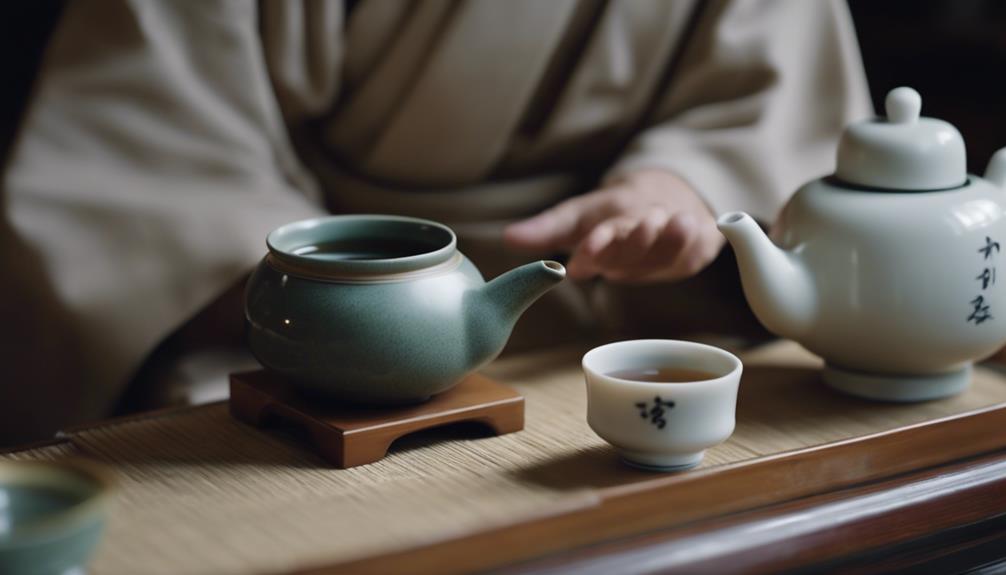
Experience the rich cultural heritage of Korean Darye tea etiquette by delving into the intricate customs and rituals observed during tea ceremonies in Korea. The Darye ceremony, a formal tea gathering in Korean tradition, highlights values of respect, harmony, and mindfulness. Upon entering the tea ceremony room, it's customary to bow as a gesture of reverence towards the host. Seating arrangements play a significant role, with the guest of honor typically positioned facing east to symbolize optimism and new beginnings.
Throughout the ceremony, a serene atmosphere is maintained to appreciate the natural sounds and the brewing process of the tea. When presented with tea, it's customary to hold the cup with both hands as a sign of appreciation towards the server. Sipping the tea should be done quietly, without disturbing the tranquility of the moment. Avoiding loud noises and distractions is essential for fully engaging in the peaceful ambiance of the ceremony. By observing these etiquette guidelines, participants pay homage to the profound cultural importance of tea ceremonies in Korea.
American Tea Party Trends
Tea parties in the United States have undergone a transformation, blending tradition with modernity to create diverse and personalized experiences for attendees.
- Backyard Socials: Imagine a sunny afternoon where friends gather in a charmingly decorated backyard, enjoying iced tea from rustic mason jars, surrounded by twinkling fairy lights and vibrant cushions.
- Thematic Celebrations: Picture a tea party themed around a beloved book or movie, where guests immerse themselves by dressing up as characters, while the table is adorned with enchanting decor that transports everyone to a fantastical realm.
- Engaging Gatherings: Envision a tea party where guests partake in tea blending workshops to craft unique flavors or participate in tea tasting sessions to explore a diverse array of brews from various regions.
These trends signify a shift towards creating experiential and customized tea party settings that cater to a wide range of preferences and interests.
African Tea Utensils Diversity
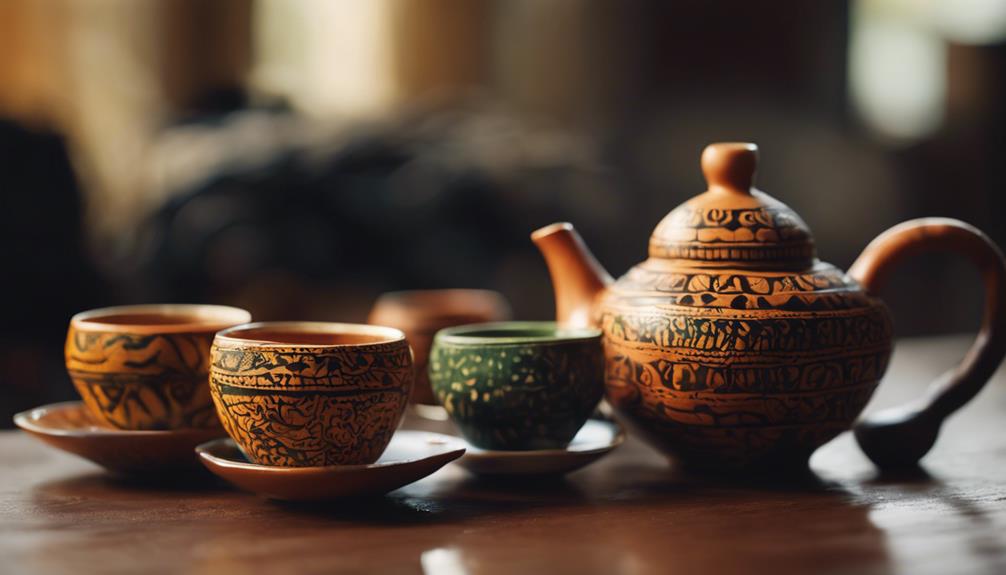
Exploring the diverse range of African tea utensils reveals a tapestry of unique designs that embody the rich cultural heritage of various regions. These utensils, steeped in tradition, play a vital role in traditional tea ceremonies, underscoring the deep-rooted significance of tea in African communities. Delving into the meanings encapsulated within these varied utensils offers a glimpse into the historical narratives and customs of diverse African cultures.
African tea utensils encompass a wide array of objects, including teapots, cups, saucers, and stirring sticks, each intricately crafted to reflect the cultural ethos of the community they hail from. These artifacts serve as more than just functional tools for brewing and serving tea; they're symbolic conduits of tradition, storytelling, and social cohesion within African societies.
In examining the intricate designs and motifs adorning these utensils, one can unravel a tapestry of stories, myths, and symbols that are passed down through generations. From intricate geometric patterns symbolizing unity and harmony to figurative representations of ancestral spirits and deities, each piece carries a unique narrative that speaks to the values and beliefs of its cultural milieu.
Moreover, the materials used in crafting these utensils, such as clay, wood, gourds, or metal, add another layer of cultural significance. For instance, the use of specific woods or metals may symbolize connections to nature or spiritual realms, while the choice of colors and textures can evoke specific emotions or invoke ancestral blessings.
Unique African Designs
African tea sets showcase a wide array of distinctive designs and utensils that reflect the diverse cultures across the continent. Here are some examples that illustrate the innovation and skill evident in African tea sets:
- Kente Cloth-inspired Teapot: Envision a teapot adorned with vibrant colors and geometric patterns inspired by Ghana's traditional Kente cloth, capturing the essence of this renowned textile art form.
- Maasai Beaded Tea Cups: Picture delicate tea cups intricately adorned with colorful Maasai beadwork, highlighting the intricate craftsmanship of the Maasai people from East Africa and their vibrant cultural expressions.
- Calabash Gourd Tea Infuser: Imagine a tea infuser crafted from a dried calabash gourd, a material commonly utilized in various African cultures for creating utensils, adding a unique and natural element to the tea brewing experience.
Cultural Significance of Utensils
Exploring the diverse African tea utensils reveals the intricate cultural tapestry woven into each unique piece. Across the continent, a myriad of tea utensils showcases the rich traditions and customs of different African cultures.
From the ornate Moroccan tea glasses symbolizing hospitality and friendship to the skillfully crafted wooden tea scoops from West Africa representing heritage and craftsmanship, each utensil bears significant cultural importance. Additionally, the beaded tea cozies from South Africa reflect a burst of vibrant colors and tribal aesthetics.
These utensils serve as tangible embodiments of the diverse cultural expressions found in African tea ceremonies.
Australian Indigenous Tea Vessels
Australian Indigenous tea vessels embody a multifaceted cultural legacy and intricate artisanship. These vessels, crafted from natural resources indigenous to the Australian terrain, transcend mere utilitarian purposes to symbolize tradition and a profound connection to the land. Engaging with an Australian Indigenous tea vessel offers a tactile encounter with history and cultural heritage. Here are three defining characteristics that set these vessels apart:
- Earthy Aesthetics: Adorned with ochre and other earthy tones, these vessels capture the essence of the Australian outback's hues. The warm, grounding colors evoke a harmonious relationship with nature.
- Intricate Symbolism: Each vessel showcases intricate carvings featuring traditional Indigenous motifs and patterns. These designs narrate stories or convey specific meanings, inviting a contemplative journey into ancient narratives.
- Sustainable Sourcing: Crafted predominantly from clay, wood, or plant fibers, these vessels exemplify Indigenous communities' sustainable practices. By using these vessels, one can feel a profound connection to the environment and the ethos of sustainable coexistence.
South American Mate Gourd Customs
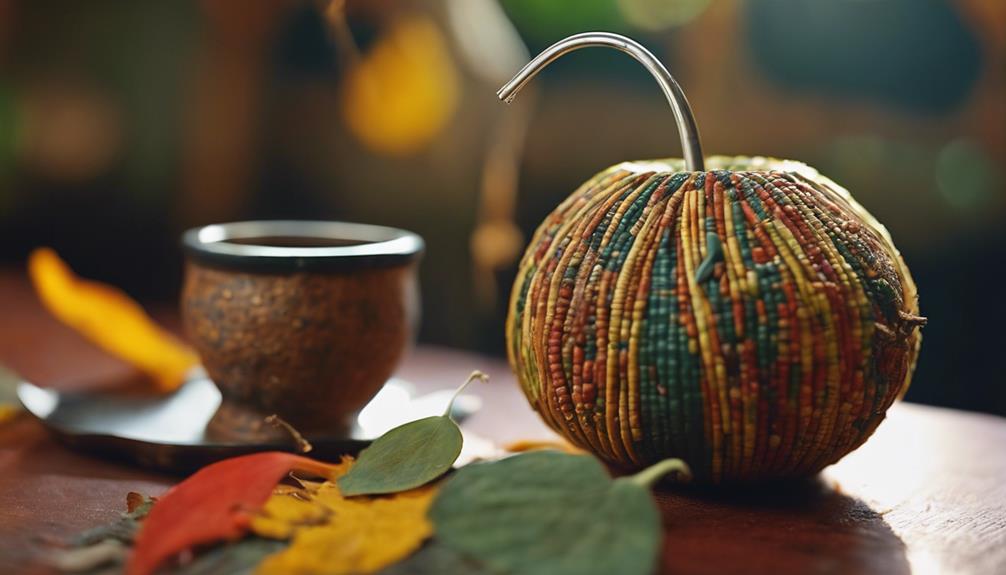
In South America, the Mate Gourd Customs have been a cherished tradition for centuries, embodying a rich cultural practice centered around community ties and shared moments. Countries like Argentina, Uruguay, Paraguay, and parts of Brazil have embraced this tradition wholeheartedly. The mate gourd, crafted from a hollowed-out calabash gourd, serves as the vessel for yerba mate leaves and hot water infusion, creating a robust herbal tea. Beyond its function as a beverage, this ritual symbolizes camaraderie, reliance, and unity among individuals.
Participating in a mate circle involves a set of etiquettes where the host initiates the gathering by preparing and enjoying the first mate, then refilling the gourd and passing it clockwise to the next participant. Each sip taken is savored, fostering open conversations and reinforcing the bonds within the group of friends or family members. The act of sharing mate transcends mere drinking; it encapsulates a profound sense of belonging and solidarity that holds significant value in South American culture.
Frequently Asked Questions
What Are the Environmental Impacts of Modern Tea Set Production?
When crafting modern tea sets, it is essential to consider their environmental impact. This includes every stage from sourcing materials to manufacturing processes. Opting for sustainable and eco-friendly options can help minimize harm to the environment and support responsible production practices. By choosing materials and processes that are environmentally friendly, you can contribute to a more sustainable tea set industry.
How Do Tea Sets Vary in Size and Capacity Across Different Cultures?
Tea sets exhibit a range of sizes and capacities across diverse cultures, showcasing unique traditions and preferences. In Japan, delicate tea sets designed for small servings embody an elegant and minimalist style, while in China, elaborate tea sets cater to communal gatherings with intricate designs. Each culture imbues its tea rituals with distinctive characteristics through the variety of tea sets used.
Are There Any Superstitions or Taboos Surrounding Tea Set Usage?
Respecting cultural beliefs and traditions is crucial when using tea sets in certain cultures. It is essential to be aware of any superstitions or taboos associated with the handling of tea sets and to show consideration for specific rituals or customs linked to their usage.
What Role Do Tea Sets Play in Contemporary Art and Design?
Tea sets in contemporary art and design function as both practical items and artistic statements, embodying tradition, creativity, and refinement. They are emblematic of cultural heritage and aesthetic sensibilities, elevating everyday experiences with an air of sophistication and inspiration for artistic endeavors.
Can Tea Sets Be Customized or Personalized for Special Occasions?
Customizing or personalizing tea sets for special occasions is a wonderful way to add a personal touch and make the gift more memorable. You can incorporate initials, significant dates, or unique designs to create a one-of-a-kind tea set that holds sentimental value for the recipient.
Conclusion
Journeying through the diverse world of tea sets offers a glimpse into the rich tapestry of cultural traditions and customs that accompany this cherished beverage. From the elaborate ceremonies of Japan to the refined high teas of Britain, each tea set narrates a unique tale of its origins and the people who hold it dear.
Whether enjoying Moroccan mint tea or partaking in mate gourd sharing in South America, tea sets serve as bridges connecting different cultures and traditions worldwide.
Here's to the fascinating realm of tea, where stories are brewed and shared across the globe!
